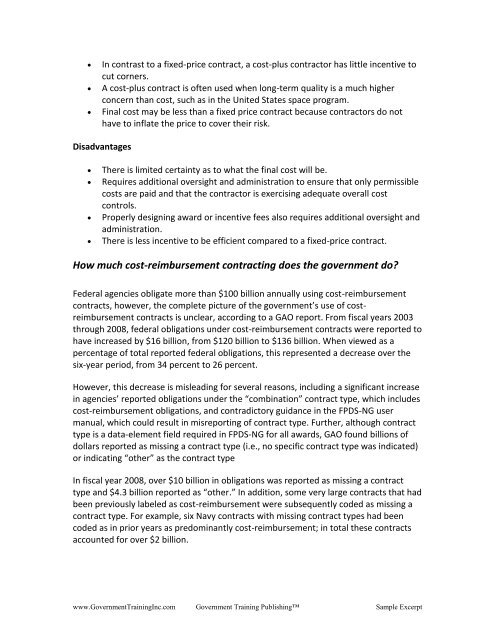Managing Cost Reimbursable Contracts - Government Training Inc.
Managing Cost Reimbursable Contracts - Government Training Inc.
Managing Cost Reimbursable Contracts - Government Training Inc.
Create successful ePaper yourself
Turn your PDF publications into a flip-book with our unique Google optimized e-Paper software.
In contrast to a fixed-price contract, a cost-plus contractor has little incentive to<br />
cut corners.<br />
A cost-plus contract is often used when long-term quality is a much higher<br />
concern than cost, such as in the United States space program.<br />
Final cost may be less than a fixed price contract because contractors do not<br />
have to inflate the price to cover their risk.<br />
Disadvantages<br />
<br />
<br />
<br />
<br />
There is limited certainty as to what the final cost will be.<br />
Requires additional oversight and administration to ensure that only permissible<br />
costs are paid and that the contractor is exercising adequate overall cost<br />
controls.<br />
Properly designing award or incentive fees also requires additional oversight and<br />
administration.<br />
There is less incentive to be efficient compared to a fixed-price contract.<br />
How much cost-reimbursement contracting does the government do<br />
Federal agencies obligate more than $100 billion annually using cost-reimbursement<br />
contracts, however, the complete picture of the government’s use of costreimbursement<br />
contracts is unclear, according to a GAO report. From fiscal years 2003<br />
through 2008, federal obligations under cost-reimbursement contracts were reported to<br />
have increased by $16 billion, from $120 billion to $136 billion. When viewed as a<br />
percentage of total reported federal obligations, this represented a decrease over the<br />
six-year period, from 34 percent to 26 percent.<br />
However, this decrease is misleading for several reasons, including a significant increase<br />
in agencies’ reported obligations under the “combination” contract type, which includes<br />
cost-reimbursement obligations, and contradictory guidance in the FPDS-NG user<br />
manual, which could result in misreporting of contract type. Further, although contract<br />
type is a data-element field required in FPDS-NG for all awards, GAO found billions of<br />
dollars reported as missing a contract type (i.e., no specific contract type was indicated)<br />
or indicating “other” as the contract type<br />
In fiscal year 2008, over $10 billion in obligations was reported as missing a contract<br />
type and $4.3 billion reported as “other.” In addition, some very large contracts that had<br />
been previously labeled as cost-reimbursement were subsequently coded as missing a<br />
contract type. For example, six Navy contracts with missing contract types had been<br />
coded as in prior years as predominantly cost-reimbursement; in total these contracts<br />
accounted for over $2 billion.<br />
www.<strong>Government</strong><strong>Training</strong><strong>Inc</strong>.com <strong>Government</strong> <strong>Training</strong> Publishing Sample Excerpt






